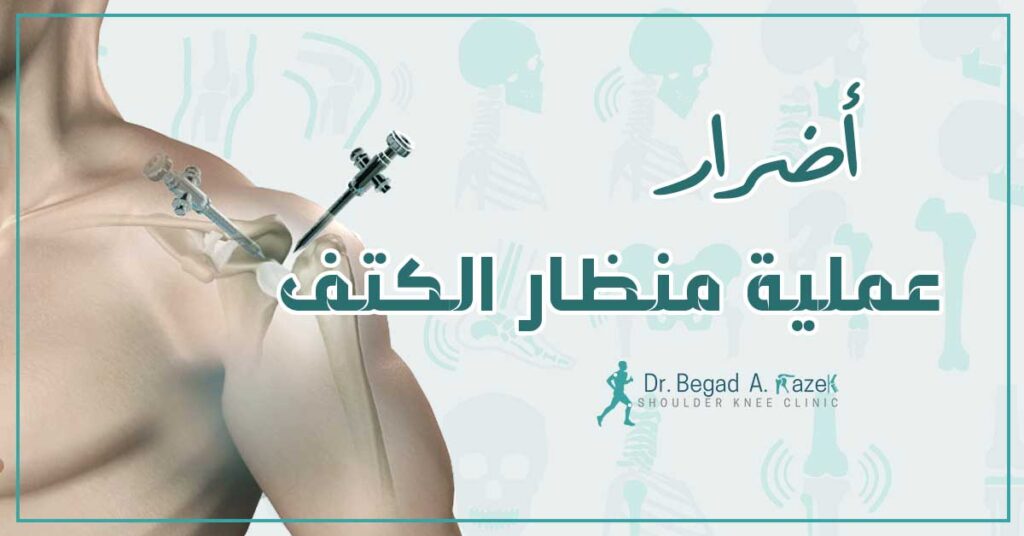
shoulder arthroscopy is a surgical procedure used to diagnose and treat shoulder problems, such as sports injuries, arthritis, or benign tumors. Although shoulder arthroscopy is usually safe and effective, it may be associated with some risks and potential harm, including the following:
- Inflammation or infection: Joint inflammation or infection may occur due to surgery. This usually requires the use of antibiotics to treat.
- Bleeding: Internal bleeding may occur in the shoulder joint during surgery, which requires special monitoring and care.
- Blood clotting: Blood clots may occur in the blood vessels after surgery, and this may require drug treatment to prevent clot formation.
- Pain and swelling: You may feel pain and swelling in the area near the wound after the procedure. Pain can be relieved with analgesic medications.
- Scar formation: A small scar may form at the site of the wound. This scar is usually small and painless.
- Risk of tendon rupture: Tendon rupture may occur during surgery, and this could require additional surgical intervention.
- You may need time to recover: Recovery after shoulder arthroscopic surgery may take a few weeks, and in some cases the person may need physical therapy sessions to fully regain strength and movement of the shoulder.
You must consult your doctor before undertaking any surgical procedure to understand the potential risks and benefits and make an informed decision.
Advantages of shoulder arthroscopy
Shoulder arthroscopic surgery has several advantages, the most prominent of which are:
- Less invasive surgery: Shoulder arthroscopy is a non-surgical, open procedure, in which a small instrument is inserted through a small hole in the skin. Therefore, it requires less surgical intervention compared to traditional shoulder surgery.
- Less recovery time: Due to the minimal surgical intervention, shoulder arthroscopic surgery usually requires a shorter recovery period compared to traditional surgery. Patients can return to their daily activities faster and begin physical therapy quickly.
- Reducing risks: Although any surgical procedure carries some risks, shoulder arthroscopy is usually safe and reduces the risk of infection, bleeding, and large scarring.
- Accurate diagnosis: The shoulder arthroscope allows the surgeon to directly see and evaluate the tissues and joints in the shoulder. They can accurately diagnose problems and take action to treat them.
- Possibility of surgical treatment: In addition to diagnosis, surgical treatment of detected problems can also be done in the same session. The surgeon may repair damaged tissue, remove polyps, or repair torn tendons.
- Better Cosmetic Results: Due to the small incisions used in shoulder arthroscopy, the cosmetic results are often better compared to traditional surgery. Scarring becomes less and less noticeable and can disappear quickly.
You must speak with your specialist orthopedic surgeon to understand the exact features of shoulder arthroscopy and to evaluate whether it is suitable for your situation.
Recovery time from shoulder arthroscopic surgery
The recovery period from shoulder arthroscopic surgery varies from person to person and depends on several factors, including the type of surgery performed, the severity of the shoulder problem, and the patient’s overall health. However, the following general guidelines can help you understand what to expect during your recovery period:
- The first days: In the first days after surgery, you may feel pain and swelling in the shoulder area. A bandage or tape will be applied to stabilize the shoulder and reduce movement. Analgesic medications may be prescribed to relieve pain.
- Week 1: One week after surgery, the bandage may be removed and you are allowed to begin the normal process of slight movement in the shoulder. You may need to use an assistive device such as a cast or medical device to support the shoulder and improve stability.
- The first three weeks: During this period, you may be directed to physical therapy to improve range of motion and strengthen the muscles surrounding the shoulder. You are taught special exercises to do at home as well.
- The first three months: During this period, normal daily activities can slowly resume. You may need to be careful and avoid excessive or forceful movements that may weaken the shoulder or affect the recovery process.
- After Three Months: Your shoulder can feel much better and be able to regain full motion and strength. Some may need a longer period to fully recover, depending on their condition.
- Most people take between 3 to 6 months to fully recover after shoulder arthroscopic surgery
